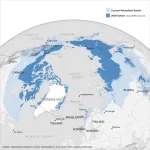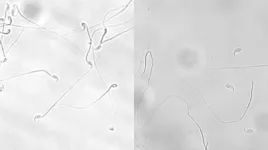(Press-News.org) Researchers at Karolinska Institutet in Sweden have used DNA origami, the art of folding DNA into desired structures, to show how an important cell receptor can be activated in a previously unknown way. The result opens new avenues for understanding how the Notch signalling pathway works and how it is involved in several serious diseases. The study is published in Nature Communications.
Notch is a cell receptor that is of great importance to a wide range of organisms and plays a crucial role in many different processes, including early embryonic development in both flies and humans. Notch regulates the development of stem cells into different cell types in the body. Defects in this signalling pathway can result in serious diseases, including cancer.
The prevailing view of the receptor’s function has so far been that it is activated purely mechanically, by a neighbouring cell pulling on it, meaning that signalling only occurs as a result of direct communication between cells.
However, researchers at Karolinska Institutet now report that the activation of Notch can also be achieved ‘on demand’ with the help of a protein called Jag1. The researchers placed the protein on a DNA structure created by so-called DNA origami, a technique that makes it possible to build structures of any shape at the nanoscale using DNA as a building material. In this case, the DNA structure was moulded into a nano-sized stick that can carry the protein to the cell surface.
“This is a technique that allows us to place molecules of the Jag1 protein at very small distances from each other in different patterns, and then we have exposed these patterns to stem cells with Notch receptors,” says Björn Högberg, professor at the Department of Medical Biochemistry and Biophysics, Karolinska Institutet, who led the study together with KI researcher Ioanna Smyrlaki at the same department.
The results show that the Notch receptor can be activated to different degrees, depending on the shape of the pattern and the local concentration of the protein. However, several questions remain about how exactly this signalling takes place.
“We are now collaborating with other researchers to see if we can make this method work in vivo as well, i.e. in a mouse model and not just in test tubes,” says Björn Högberg. “This is basic research, but Notch is an important component in several diseases, including a form of leukaemia and the developmental disorder Alagille Syndrome. We therefore hope that the results will also lead to a better understanding of these diseases.”
The research was mainly funded by the Knut and Alice Wallenberg Foundation, the Swedish Research Council and the European Research Council (ERC). There are no reported conflicts of interest.
Publication: “Soluble and multivalent Jag1 DNA origami nanopatterns activate Notch without pulling force”, Ioanna Smyrlaki, Ferenc Fördös, Iris Rocamonde-Lago, Yang Wang, Boxuan Shen, Antonio Lentini, Vincent C Luca, Björn Reinius, Ana I Teixeira, Björn Högberg, Nature Communications, online 18 January 2024, doi: 10.1038/s41467-023-44059-4.
END
DNA construction led to unexpected discovery of important cell function
2024-01-18
ELSE PRESS RELEASES FROM THIS DATE:
Why animals shrink over time explained with new evolution theory
2024-01-18
The mystery behind why Alaskan horses, cryptodiran turtles and island lizards shrunk over time may have been solved in a new study.
The new theoretical research proposes that animal size over time depends on two key ecological factors: the intensity of direct competition for resources between species, and the risk of extinction from the environment.
Using computer models simulating evolution, the study, published today (Thursday, 18 January) in communications biology, identifies why some species gradually get smaller, as indicated by fossil records.
Dr Shovonlal Roy, an ecosystem modeller from the University of Reading who led the research, ...
CD19-targeted CAR NK cell therapy achieves promising one-year results in patients with B-cell malignancies
2024-01-18
Researchers from The University of Texas MD Anderson Cancer Center reported promising results in a Phase I/II trial of 37 patients with relapsed or refractory B-cell malignancies who were treated with cord blood-derived chimeric antigen receptor (CAR) natural killer (NK) cell therapy targeting CD19.
Published today in Nature Medicine, the findings reveal an overall response (OR) rate of 48.6% at 100 days post treatment, with one-year progression-free survival (PFS) and overall survival (OS) rates of 32% & 68%, respectively. The trial reported an excellent safety profile with no cases of severe cytokine release syndrome (CRS), neurotoxicity, ...
New cause of neuron death in Alzheimer's discovered
2024-01-18
· New finding to understand brain cell loss in neurodegenerative disease
· Increasing protective short RNAs may be new approach to halt or delay Alzheimer’s
· SuperAgers with superior memories have more protective short RNAs in their brains
CHICAGO --- Alzheimer’s disease, which is expected to have affected about 6.7 million patients in the U.S. in 2023, results in a substantial loss of brain cells. But the events that cause neuron death are poorly understood.
A new Northwestern Medicine study shows that RNA interference may play a key role in Alzheimer’s. For the first time, ...
Most Earth System Models are missing key piece of future climate puzzle
2024-01-18
The way science is funded is hampering Earth System Models and may be skewing important climate predictions, according to a new comment published in Nature Climate Change by Woodwell Climate Research Center and an international team of model experts.
Emissions from thawing permafrost, frozen ground in the North that contains twice as much carbon as the atmosphere does and is thawing due to human-caused climate warming, are one of the largest uncertainties in future climate projections. But accurate representation of permafrost dynamics is missing from ...
Shiyu discovery reveals East Asia’s advanced material culture by 45,000 years ago
2024-01-18
A team of researchers from China, Australia, France, Spain, and Germany has revealed advanced material culture in East Asia by 45,000 years ago.
The new study was published in Nature Ecology & Evolution on Jan. 18.
The researchers examined a previously excavated archaeological collection from the Shiyu site, located in Shanxi Province.
"Our new study identified an Initial Upper Palaeolithic archaeological assemblage from the Shiyu site of North China dating to 45,000 years ago that includes blade technology, tanged and hafted projectile points, long-distance obsidian transfer, and the use of a perforated ...
Study reveals a universal pattern of brain wave frequencies
2024-01-18
Throughout the brain’s cortex, neurons are arranged in six distinctive layers, which can be readily seen with a microscope. A team of MIT neuroscientists has now found that these layers also show distinct patterns of electrical activity, which are consistent over many brain regions and across several animal species, including humans.
The researchers found that in the topmost layers, neuron activity is dominated by rapid oscillations known as gamma waves. In the deeper layers, slower oscillations called alpha and beta waves ...
When energy doesn’t add up: 200 US cities will fall short of sustainable energy goals despite pledging to transition to renewable sources by 2050
2024-01-18
200 US communities will fail to transition to 100% renewable energy by 2050 despite their pledges to do so, according to a new study published in IOP Publishing’s journal Environmental Research: Infrastructure and Sustainability.
The study shows that by 2050 gas will firmly remain the primary source of energy in the US given that the current infrastructure plans for implementing renewable energy cannot provide sufficient energy output. Recent projections suggest that renewable energy generation will need to triple to meet even a 45% share of energy production. The results indicate that in many instances renewable energy ...
Felix Beuschlein announced as new Editor-in-Chief of the European Journal of Endocrinology
2024-01-18
The European Society of Endocrinology (ESE) is pleased to announce that the new Editor-in-Chief of our flagship journal, the European Journal of Endocrinology (EJE), is Professor Felix Beuschlein, M.D. He will assume his post in May 2024 when the current Editor in Chief, Professor Wiebke Arlt, steps down.
Professor Philippe Chanson, Chair of ESE’s Publications and Communications Committee said, “I am delighted that Felix will be the next Editor in Chief of ESE’s flagship journal and will continue to build on the strong foundations laid by his predecessors. Felix’s internationally ...
Missing gene could explain infertility
2024-01-18
Mice lacking a certain gene are unable to produce offspring because their sperm lack the connection between the tail and the head. A new thesis from the University of Gothenburg indicates a probable cause of male infertility.
Researchers at the University of Gothenburg have identified a new protein, dubbed by them as “MC2”, that plays a crucial part in the formation of swimmable sperm in mice. This protein is needed to create a functional connection between the head and the tail of the sperm.
“The connection is located in the ‘neck’ of the sperm head and facilitates coordinated movement and function ...
Scientists uncover new marine source of carbon emissions into atmosphere, finding bottom trawling contributes to global warming
2024-01-18
(WASHINGTON, DC) 18 JANUARY 2024 — Bottom trawling is a previously unaccounted for source of atmospheric carbon emissions, scientists reveal in a study published today. As the world scrambles to slash emissions caused by fossil fuels, deforestation and other sources, the study finds bottom trawling — the act of dragging a heavy fishing net across the ocean floor and resuspending some of the carbon in the seafloor sediment — to be a significant source of atmospheric carbon pollution. A previous study found that part of that disturbed ...




